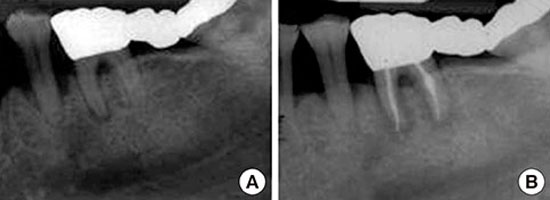1. Hallmon WW. Occlusal trauma: effect and impact on the periodontium. Ann Periodontol. 1999; 4:102–108.

2. Svanberg G. Influence of trauma from occlusion on the periodontium of dogs with normal or inflamed gingivae. Odontol Revy. 1974; 25:165–178.
3. Polson AM, Meitner SW, Zander HA. Trauma and progression of marginal periodontitis in squirrel monkeys. III Adaption of interproximal alveolar bone to repetitive injury. J Periodontal Res. 1976; 11:279–289.

4. Lindhe J, Ericsson I. The influence of trauma from occlusion on reduced but healthy periodontal tissues in dogs. J Clin Periodontol. 1976; 3:110–122.

5. Ericsson I, Lindhe J. Lack of significance of increased tooth mobility in experimental periodontitis. J Periodontol. 1984; 55:447–452.

6. Ramfjord SP, Ash MM Jr. Significance of occlusion in the etiology and treatment of early, moderate, and advanced periodontitis. J Periodontol. 1981; 52:511–517.

7. Salama H, Salama M. The role of orthodontic extrusive remodeling in the enhancement of soft and hard tissue profiles prior to implant placement: a systematic approach to the management of extraction site defects. Int J Periodontics Restorative Dent. 1993; 13:312–333.
8. Ingber JS. Forced eruption. I. A method of treating isolated one and two wall infrabony osseous defects-rationale and case report. J Periodontol. 1974; 45:199–206.

9. Steedle JR, Proffit WR. The pattern and control of eruptive tooth movements. Am J Orthod. 1985; 87:56–66.

10. Frank CA, Pearson BS, Booker BW. Orthodontic eruption of furca-involved molars. Compend Contin Educ Dent. 1995; 16:664. 666. 668. passim.
11. Silness J, Loe H. Periodontal disease in pregnancy. II. Correlation between oral hygiene and periodontal condtion. Acta Odontol Scand. 1964; 22:121–135.

12. Löe H. The gingival index, the plaque index and the retention index systems. J Periodontol. 1967; 38:610–616.

13. Kerry GJ, Morrison EC, Ramfjord SP, Hill RW, Caffesse RG, Nissle RR, et al. Effect of periodontal treatment on tooth mobility. J Periodontol. 1982; 53:635–638.

14. Pihlstrom BL, McHugh RB, Oliphant TH, Ortiz-Campos C. Comparison of surgical and nonsurgical treatment of periodontal disease: a review of current studies and additional results after 61/2 years. J Clin Periodontol. 1983; 10:524–541.

15. Suvan JE. Effectiveness of mechanical nonsurgical pocket therapy. Periodontol 2000. 2005; 37:48–71.

16. Ramfjord S, Ash M. Occlusion. Philadelphia: WB Saunders;1983.
17. Kantor M, Polson AM, Zander HA. Alveolar bone regeneration after removal of inflammatory and traumatic factors. J Periodontol. 1976; 47:687–695.

18. Everett FG, Baer PN. A preliminary report on the treatment of the osseous defect in periodontosis. J Periodontol. 1964; 35:429–435.

19. Demirel K, Gur H, Meric H, Sevuk C. Damping characteristics of teeth with periodontal breakdown: correlation of mobility meter values with bone and attachment loss. J Periodontol. 1997; 68:166–171.

20. Kajiyama K, Murakami T, Yokota S. Gingival reactions after experimentally induced extrusion of the upper incisors in monkeys. Am J Orthod Dentofacial Orthop. 1993; 104:36–47.

21. Mankoo T, Frost L. Rehabilitation of esthetics in advanced periodontal cases using orthodontics for vertical hard and soft tissue regeneration prior to implants: a report of 2 challenging cases treated with an interdisciplinary approach. Eur J Esthet Dent. 2011; 6:376–404.
22. Lin CD, Chang SS, Liou CS, Dong DR, Fu E. Management of interdental papillae loss with forced eruption, immediate implantation, and root-form pontic. J Periodontol. 2006; 77:135–141.

23. Graber TM, Adams PE. Current orthodontic concepts and techniques. Philadelphia: Saunders;1969.






 PDF
PDF ePub
ePub Citation
Citation Print
Print




 XML Download
XML Download